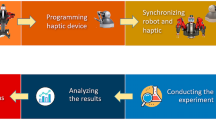Abstract
The human–computer interface remains a mostly visual environment with little or no haptic interaction. While haptics is finding inroads in specialized areas such as surgery, gaming, and robotics, there has been little work to bring haptics to the computer desktop, which is largely dominated today by the GUI/mouse relationship. The mouse as an input device, however, poses many challenges for users with physical disabilities, and it is believed that a haptically enhanced interface could have significant impact assisting in target selection. This paper presents a study intended to evaluate haptic effects used with a force feedback mouse on a computer desktop and a prediction algorithm designed to focus those effects on the desired target. Results of the experiment were partially successful and indicated future directions for improvement. The paper introduces the proposed framework and presents experimental results from targeting tasks using differing haptic effects with a group of physically disabled users.




Similar content being viewed by others
References
Abbott, J., Marayong, P., Okamura, M.: Haptic virtual fixtures for robot-assisted manipulation. In: Thrun, S., Brooks, R., Durrant-Whyte, H. (eds.) Robotics Research: Results of the 12th International Symposium ISRR, pp. 49–64. Springer (2007)
Adams, R.J., Moreyra, M.R., Hannaford, B.: Stability and performance of haptic displays: Theory and experiments. In: Proc. ASME Int. Mechanical Eng. Congress, pp. 227–234. Anaheim, CA (1998)
Angelini, M., Langdon, P., Bracewell, R.: Designing a haptic feedback mouse for disabled assistance. Technical report, Engineering Design Centre, Cambridge, U.K. (2002)
Boessenkool, J.: Moving two hands: common versus independent control. PhD thesis, University Utrecht, The Netherlands (1999)
Cerebral palsy—Wikipedia, the free encyclopedia. http://www.en.wikipedia.org/wiki/cerebral_palsy
Dennerlein, J., Yang, M.: Haptic force-feedback devices for the office computer: Performance and musculoskeletal loading issues. Hum. Factors 43(2), 278–286 (2001)
Disability Info: Cerebral Palsy Fact Sheet (FS2). http://www.nichcy.org/pubs/factshe/fs2txt.ht..
Fitts, P., Peterson, J.: Information capacity of discrete motor responses. J. Exp. Psychol. 67(2), 103–112 (1964)
Fitts, P.M.: The information capacity of the human motor system in controlling the amplitude of movement. J. Exp. Psychol. 47(6):381–391 (1954). Reprinted in J. Exp. Psychol.: General 121(3):262–269 (1992)
Gan, K., Hoffmann, E.: Geometrical conditions for ballistic and visually controlled movements. Ergonomics 31, 829–839 (1988)
Hwang, F., Keates, S., Langdon, P., Clarkson, P.J., Robinson, P.: Perception and Haptics: Towards More Accessible Computers for Motion-Impaired Users. University of Cambridge, Cambridge (2001)
Ivanov, I., Zafirova, T., Jordanova, N.: On mice and handicapped children. In: Proc. EUROLOG’01, 8th Europ. Logo Conf., pp. 21–25. Linz, Austria (2001)
Jagdish, D., Sawhney, R., Gupta, M., Nangia, S.: Sonic grid: An auditory interface for the visually impaired to navigate gui-based environments. In: Proc. 13th International Conference on Intelligent User Interfaces, pp. 337–340 (2008)
Langdon, P., Hwang, F., Keates, S., Clarkson, P., Robinson, P.: Investigating haptic assistive interfaces for motion-impaired users: Force-channels and competitive attractive basins. In: Proc. Eurohaptics, pp. 122–127 (2002)
Meulenbroek, R., Thomassen, A.: Effects of handedness and arm position on stroke-direction preference in drawing. Psychol. Res. 54, 194–201 (1992)
Murata, A.: Improvement of pointing time by predicting targets in pointing with a pc mouse. Int. J. Hum. Comput. Int. 10(1), 23–32 (1998)
Oakley, I., Adams, A., Brewster, S., Gray, P.: Guidelines for the design of haptic widgets. In: Proc. BCS HCI’02, pp. 195–212. Springer (2002)
Oakley, I., Brewster, S., Gray, P.: Solving multi target haptic problems in menu interaction. Technical report, Glasgow Interactive Systems Group, University of Glasgow, Glasgow, G12 8QQ, U.K. (2001)
Oakley, I., McGee, M.R., Brewster, S., Gray, P.: Putting the feel in ’look and feel’. Technical report, Glasgow Interactive Systems Group, University of Glasgow, Glasgow, G12 8QQ, U.K. (2001)
Owen, W., Doran, M., Holbert, B.: Performance in a haptic environment. Issues Inf. Sys. III:165–171 (2002)
Sakr, N., Georganas, N., Zhao, J., Shen, X.: Motion and force prediction in haptic media. In: Proc. ICME’2007, pp. 2242–2245 (2007)
Thomson, E.: Probes causes, aids for arm tremor. MIT Tech Talk, 36(28) (1992)
Types of Assistive Technology Products. http://www.microsoft.com/enable/at/types.asp
Wall, S., Harwin, W.: Quantification of the effects of haptic feedback during motor skills tasks in a simulated environment. In: Proc. 2nd PHANToM Users Research Symposium, pp. 61–69. Zurich, Switzerland, July (2000)
Welford, A.: The measurement of sensory-motor performance: Survey and reappraisal of twelve years’ progress. Ergonomics 3, 189–230 (1960)
Williams, J., Michelitsch, G.: Designing effective haptic interaction: inverted damping. In: Proc. CHI ’03 extended abstracts on Human factors in computing systems, Ft. Lauderdale, FL, USA (2003)
Author information
Authors and Affiliations
Corresponding author
Rights and permissions
About this article
Cite this article
Holbert, B., Huber, M. Design and evaluation of haptic effects for use in a computer desktop for the physically disabled. Univ Access Inf Soc 10, 165–178 (2011). https://doi.org/10.1007/s10209-010-0192-x
Published:
Issue Date:
DOI: https://doi.org/10.1007/s10209-010-0192-x




